The Ecotypes Project Returns for a New Game of Tundra Chess
April 5, 2022
Haley Dunleavy
907-474-6407
In the Arctic’s short summer growing season, timing is everything. From snowmelt to senescence, tundra plants race to send out their annual set of leaves, flowers, and fruit while producing enough energy to support their dormancy through the winter months. But as climate change extends Arctic summers, some plants appear to be better able to respond, staying green—and fixing carbon—for longer. Researchers at Toolik Field Station want to know how well Eriophorum vaginatum, commonly known as tussock cottongrass, can adjust to the longer growing season—and what that may mean for the tundra at large.
Last fall, Ned Fetcher, Michael Moody, Gus Shaver, and Jim Tang were awarded a combined $1.1 million collaborative research grant from the National Science Foundation to study the ties between phenology and genetics as Eriophorum, the foundational namesake in Alaska’s moist acidic tussock tundra, responds to a warming Arctic. Known as the Ecotypes project, the researchers’ previous work has been a staple at Toolik since the station’s early development. Its roots trace back to 1979, when Fetcher, now a plant ecologist at Wilkes University, was interested in the classic ecological question: does a plant’s environment or its genetics carry more weight in determining variation within a species?

The Ecotypes experiment uses open top chambers to passively warm the tundra near Toolik Field Station. |
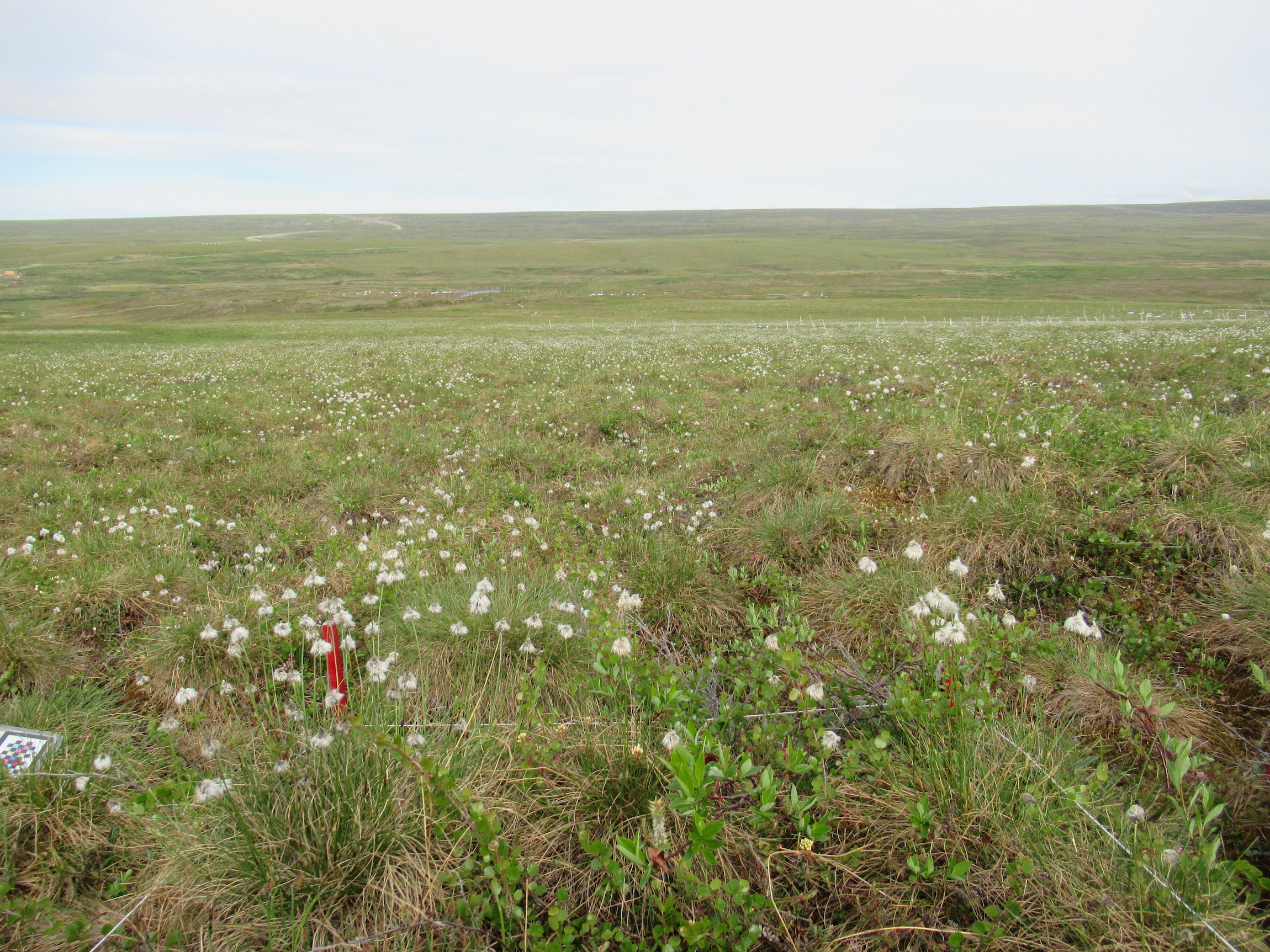
Eriophorum vaginatum, also known as Alaska cottongrass, fills the tundra with its fluffy white tuffs of seeds. |
To explore this question, Fetcher and colleagues, including Shaver, transplanted Eriophorum tussocks across a latitudinal temperature gradient from Eagle Creek up to Prudhoe Bay. Shaver was studying variation in tundra plants along the Dalton Highway and invited Fetcher along for the drive. During that trip, Fetcher said they got the idea to transplant tussocks in hopes of better identifying some of the drivers of variation within Eriophorum. In total, six reciprocal transplant gardens were initially established, the success of which Fetcher said was partly due to Eriophorum’s annual root system. “You could slice off the tussock without disturbing the soil, without digging up roots, without going through all that business,” Fetcher said. “Just slice off the tussocks and move them around like you would pieces on a chessboard.”
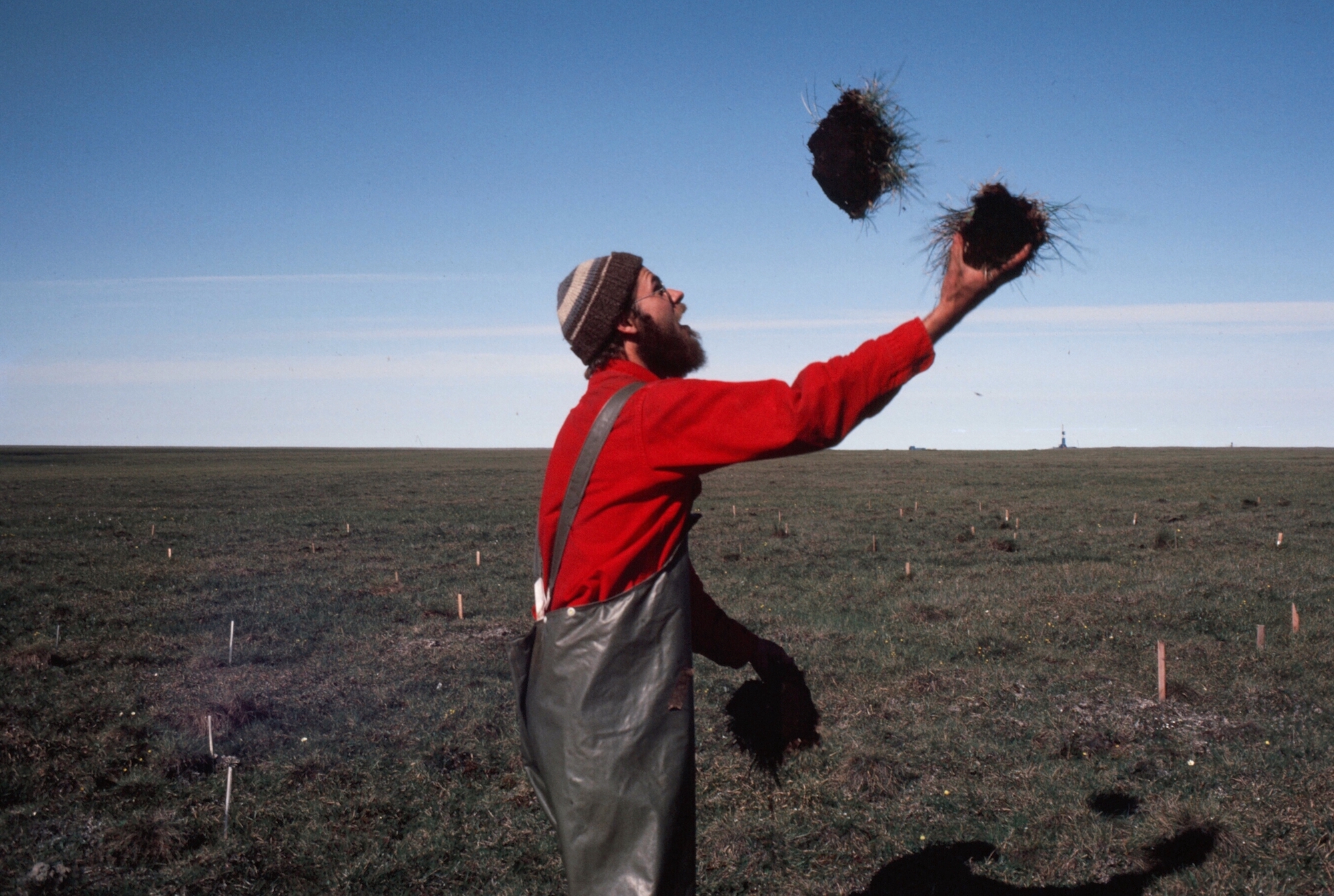
Knut Kielland, a researcher at the University of Alaska Fairbanks, juggles cottongrass while transplanting tussocks in 1980 across the North Slope of the Brooks Range.
Since the start of the first Ecotypes experiment, Fetcher and his collaborators have played a lot of Eriophorum chess, establishing additional transplant experiments between Coldfoot, Toolik, and Sagwon and tracking tussock growth, survival, and senescence in old ones. Though the researchers’ initial goal was to understand local adaptation among ecotypes, Fetcher said that the focus of Ecotypes shifted as climate change moved to the forefront of ecologists’ concerns. “I speculated that these differences that we found in the response of these ecotypes could affect what happens with Arctic change,” he said. “If something stays green longer or stays green later, that's going to affect ecosystem properties, like nutrient retention or primary productivity,” Fetcher added. Because tussocks are a key player in the Alaskan tundra, “this is a case where ecotypic variation could actually make a difference.”
The researchers have indeed found strong evidence that climate change interacts with ecotypic differences. For instance, Eriophorum splits into two genetically distinct ecotypes: one northern and the other southern, geographically separated latitudinal treeline, near the Chandalar Shelf. Fetcher and collaborators found differences between the two ecotypes that can persist for at least 30 years after transplanting. Southern tussocks are larger and have a longer growing season than northern tussocks, even when experimentally transplanted to northern regions like Toolik. In contrast, northern populations don’t seem to extend their growing season when either transplanted south or artificially warmed in the north. This might mean that northern ecotypes lose out in a hotter Arctic despite the lengthened potential growing season. And though southern ecotypes appear to be better adapted to living in a warmer climate, their ability to thrive in northern locations ultimately depends on whether or not they could migrate northward. Fetcher and colleagues suspect that’s unlikely at a pace that matches that of climate change, leaving Eriophorum’s future in a state of uncertainty.
Re-examining Core Drivers
The Ecotypes group has largely centered their efforts on the role that temperature plays in differences among Eriophorum populations. But, Fetcher said, their research has missed a key factor: light. “There have been lots of studies of phenology in the Arctic,” he said. “Basically they find that when spring comes, things start to grow and then they start to senesce in the fall in August. [These studies conclude] that it's tied with temperature, but very few studies really considered light regime.”
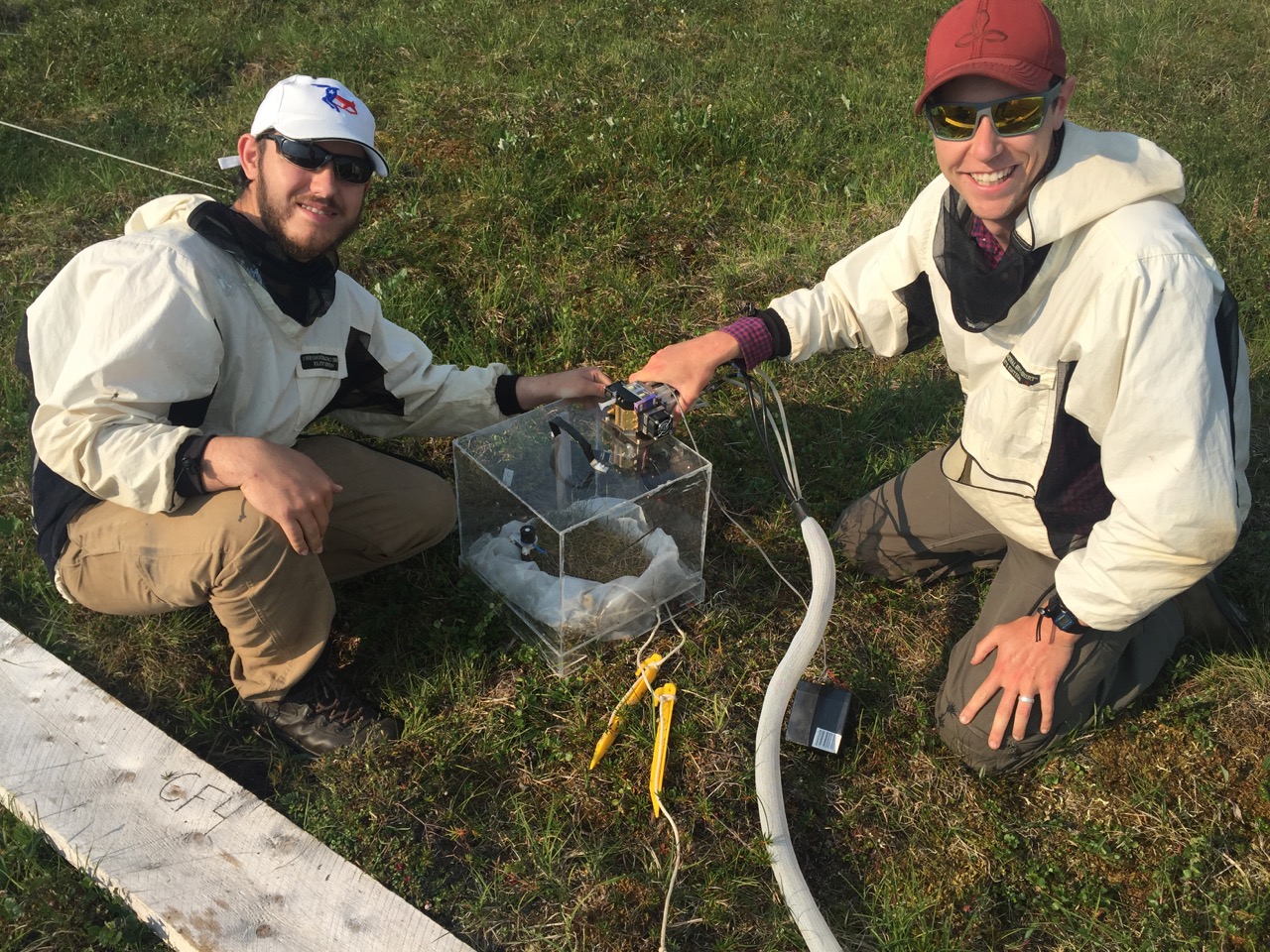
Steve Unger, a research assistant, and Tom Parker, a postdoctoral researcher, measure gas exchange on a transplanted tussock in the Ecotypes experimental plots.
When tussocks are transplanted, they’re not just entering a new temperature regime. They also experience a different photoperiod. Southern ecotypes in northern common gardens suddenly enter an area with longer daylight hours while northern ecotypes that are transferred to southern gardens experience darkness earlier into the season. Fetcher found in preliminary greenhouse experiments that tussocks exposed to three hours of darkness senesced earlier compared to tussocks grown in 24 hours of light. In the field, Eriophorum’s response to light might interact with its response to warming. “As things warm up, the southern ecotype may be able to migrate north,” he said. “But then it's going to be in a different photoperiod and may not be able to respond.”
In the next round of the Ecotypes project, the research group is returning to their initial question of what’s driving differences—the environment or genetics—and asking how light factors into Eriophorum’s phenology between Coldfoot and Toolik. Michael Moody, an associate professor at University of Texas at El Paso, said their new research aims to disentangle the extent to which temperature, light quantity and quality, and genetics play a role in phenology and photosynthetic rates. “That's the exciting aspect,” Moody said, “What else is causing [these differences]? Is there an interaction between light, temperature, and other environmental factors?”
To address these questions, the researchers plan to manipulate photoperiod in the field with help from mechanical engineering students at Fetcher’s Wilkes University. He’s working with students to build automated “blackout boxes” that encapsulate tussocks at the transplant gardens in Toolik in a few hours of darkness during the never-setting summer sun of the Arctic. At Coldfoot, the team plans to simulate 24 hours of light even into the late summer months, when dark nights begin to reappear. The light manipulations will help determine the extent to which photoperiod controls phenological differences between northern and southern ecotypes.
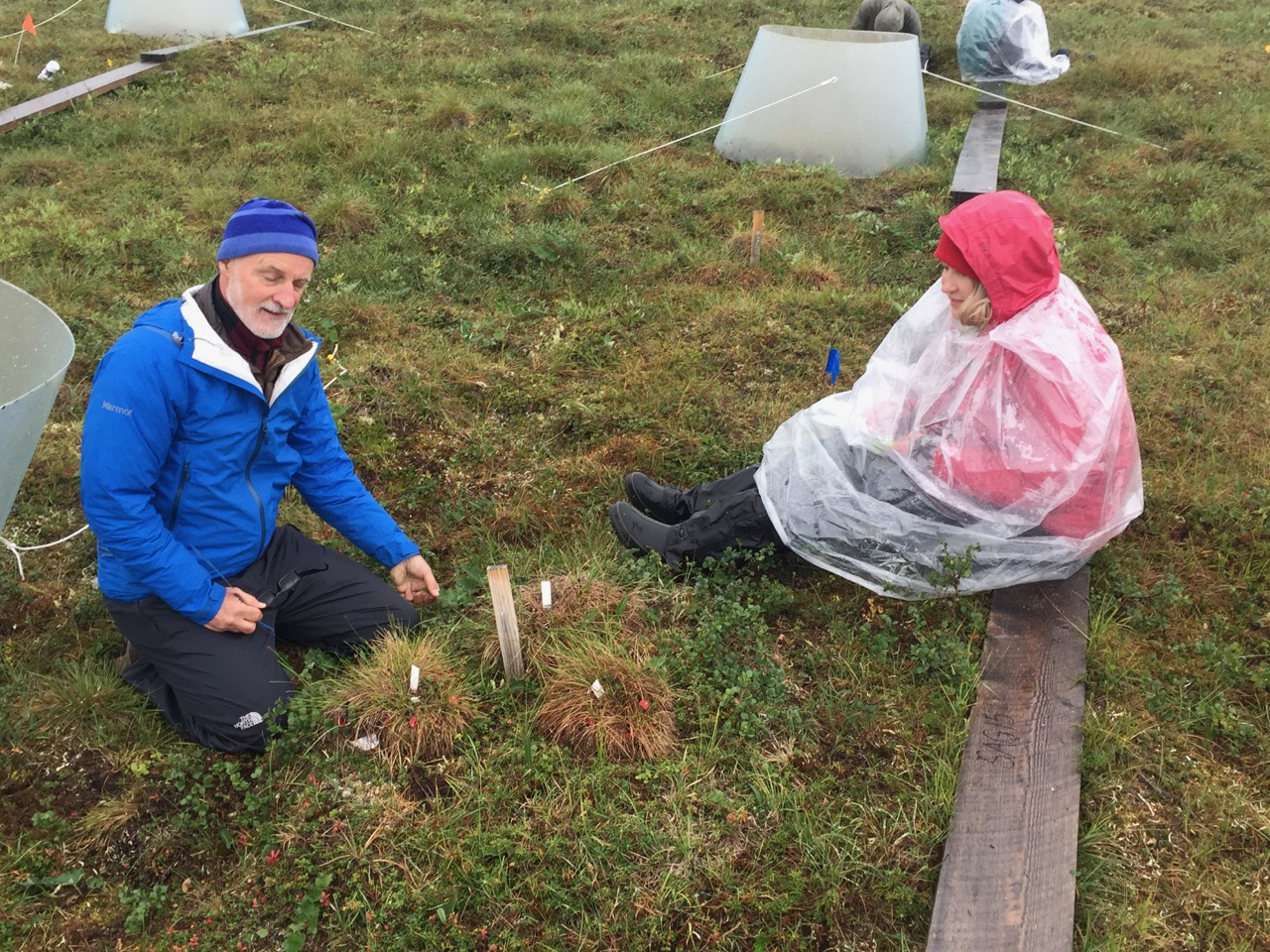
Ecotypes researcher Jim McGraw and field technician Alana Thurston examine transplanted tussocks near Toolik Field Station on a rainy summer day.
The researchers won’t just track phenology and photosynthetic rates in these new transplant and light experiments. Moody, a plant geneticist, also plans to explore the genetic controls on Eriophorum’s phenology more. His past research has shown that the two ecotypes are distinct in both their genome and in their gene expression. Moody said in addition to examining the importance of photoperiod in determining senescence, their new grant will also allow them to “link to what's happening at the genetic level and figure out which genes are signaling when to shut down” via transcriptomics.
“We can look at phenology and see that ‘yeah the phenology is different’. But by looking at the genes and transcriptome, we can start finding finer scale patterns of what really is reacting to these differences,” Moody said. This could prove useful for models projecting future tundra vegetation shifts. He added: “Most research to this point really has been treating species as one entity that doesn't have any real difference.” The Ecotypes researchers know from their previous studies that this assumed uniformity isn’t the case for Eriophorum. To better predict whether tussocks will persist in a future Arctic, Moody said, “we're going to have to think of not treating Eriophorum vaginatum as one single entity, but as multiple entities.”
Expanding in a Changing Field
Understanding the environmental and genetic controls on Eriophorum’s phenology is one move in the chess problem of Eriophorum and climate change. Also on the board is what these drivers mean in a tundra that’s not only warmer, but also shrubbier. The Ecotypes team will address this unknown by comparing responses of Eriophorum with the region’s dominant deciduous shrubs, Betula nana and Salix pulchra, two plants that are expanding across tundra ecosystems and could outcompete Eriophorum in the future.
This latest development to the grant—the added factor of shrub expansion—is just one of the ways the Ecotypes project has evolved over its decades-long run. “It's amazing where science has come over [those years since the project began],” said Moody. Take the pair’s collaborative effort to link genetics and ecology. “Back when Ned was first getting started, evolutionary biologists and ecologists never really worked together,” said Moody, who teamed up with Fetcher after they met in 2013. “It really is a history of science in a way of the project where it started to what we can do today with teams of people working on very different aspects of the science,” he added.
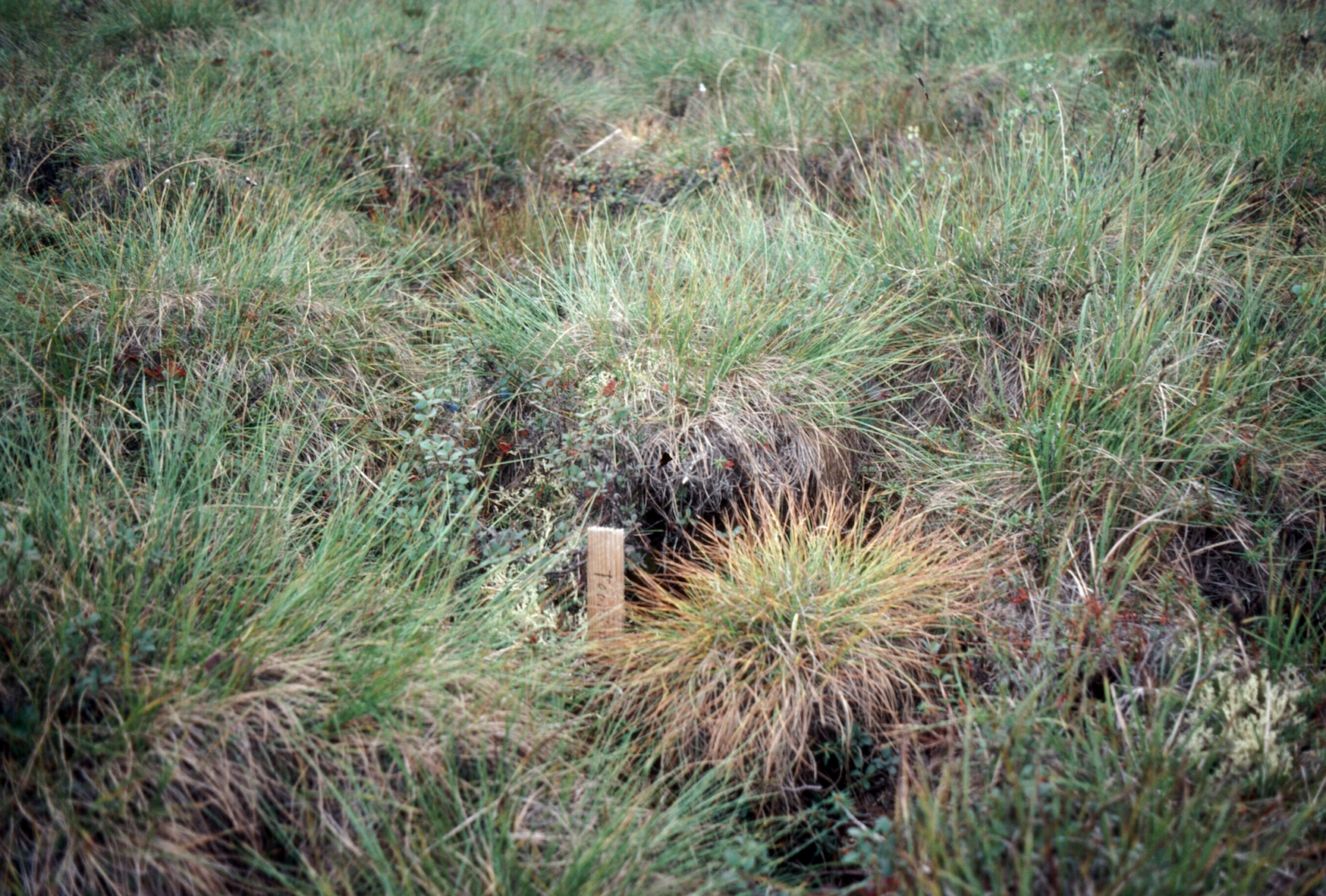
An Eriophorum vaginatum tussock, transplanted from Toolik Lake in 1979, continues to grow in the southerly site of Eagle Creek, Alaska roughly 4 years later.
Fetcher said Toolik Field Station helped support the project’s development as well. During the project’s early start at Eagle Creek, Fetcher said he and others were living in tents, using snow banks for refrigeration, and spending lots of time cooking or making grocery runs back down to Fairbanks. Over the years, Toolik has grown to better provide for those logistics, opening up more time for science and more infrastructure for advancements in technology. “Without Toolik, I don't think we could do the kinds of experiments that we've done,” Fetcher said.
Moody shared that same sentiment for Toolik. His connections at Toolik, he said, have given him opportunities to think of ecosystem dynamics under a genomics context. Moody added, “Everybody’s thinking about different aspects of what affects the Arctic, especially under climate change. It really makes it possible for you to approach new avenues of research and different ways to think about it.”
Look out for a new game of Eriophorum chess when the Ecotypes project returns to Toolik this coming summer.


